Have you ever seen a horse smile? By this, I mean raising their upper lip back into the air and showing their front teeth.
This behavior is called the “flehmen response” in horses, and the reason why they make this funny face is super interesting.
When I first saw a horse do this as a young riding lesson student, I thought the horse was laughing at something funny I did.
It wasn’t till years later that I found out I was totally wrong and learned what the horse was actually doing.
What Is The Flehmen Response In Horses?
The term “flehmen response,” also called the “flehmen reaction,” refers to a specific behavior shown by all equines at some stage during their lives.
A horse that displays the flehmen response pushes out their neck, raises its head and rolls their upper lip back to display their teeth. While they do this, the horse will also inhale through their nose.
The primary function of the flehmen response is intra-species communication. In simple terms this means another way horses can communicate with each other.
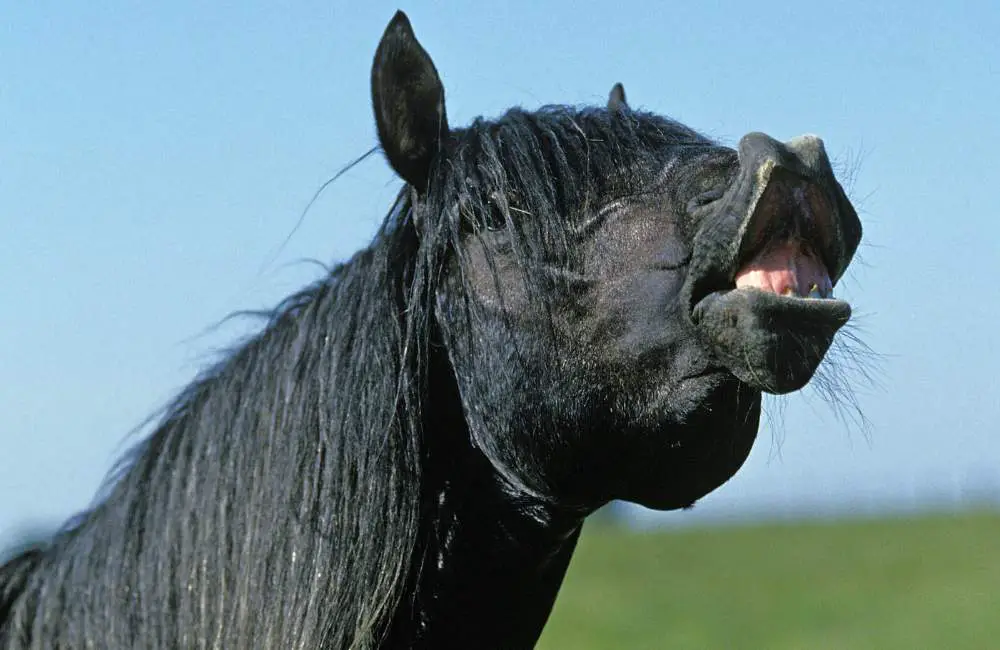
Why Do They Lift Their Upper Lip?
It’s not to smile, they lip curl to get a better whiff. Curling the upper lip allows the horse to push the scent further into their nasal passage, where it is trapped and analyzed by the vomeronasal organ (VNO).
This is why the flehmen response can show that a horse has detected something unexpected or interesting as opposed to a scent they are already familiar with.
Which is why many times when I give a peppermint to a horse that hasn’t had one in a long time end up with this response.
What is the Vomeronasal Organ?
The vomeronasal organ, also known as jacobson’s organ, is a chemosensory structure found in many mammals.
It’s surrounded by a boney or cartilaginous capsule that opens into the base of the nasal cavity. It is made up of two tubes (from the mouth and nasal passages) that lead to a sensory-lined chamber inside the organ.
Chemical signals, like pheromones, are picked up by these cells and sent to the brain through the accessory olfactory bulb.
The vomeronasal organ plays an important role in social behaviors in horses, such as mating and aggression.
In humans, the vomeronasal organ is thought to be non-functional.
Why Do Horses Lift Their Head Up?
Horses lift their heads up during the flehmen reaction because the upward head tilt seems to help airborne molecules linger for longer in the vomeronasal organ.
Origins Of the Word “Flehmen”
The word “flehmen” is German and means “to bare the upper teeth,” a rather fitting word for the “flehmen response!”
In 1930, Karl Max Schneider, who was in charge of the Leipzig Zoo, was the first person to use the term in this way.
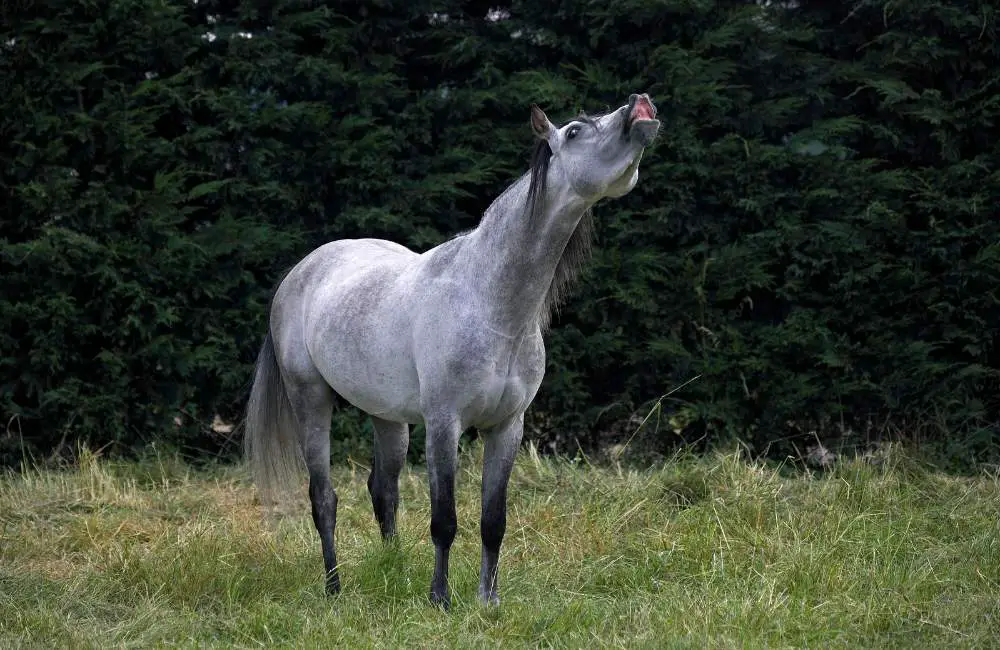
Do Horses Have A Good Sense Of Smell?
Horses have a fantastic sense of smell. It is essential to their survival that they can quickly identify the right foods to eat, poisonous plants to avoid, dirty water, and predators for wild horses.
Their sense of smell must identify foods that are safe and nutritious, such as grasses, hay, and shrubs. They must also be able to recognize poisonous plants, such as nightshade and yew, which can cause illness or death if eaten.
Also, they must be able to tell the difference between sources of clean drinking water and sources of water that may be contaminated with bacteria, parasites, or other harmful substances.
Finally, wild horses need to be able to recognize by smell any predators in the area that could pose a danger to them, such as wolves, coyotes, bears, and mountain lions.
While horses don’t have a sense of smell as powerful as dogs, theirs is far superior to our human noses. They have around 300 million scent receptors, compared to humans’ five to six million.
This means that horses have a pretty incredible sense of smell, which is why they often react to scents in their environment.
Horses can detect smells from far away, and can even distinguish individual odors.
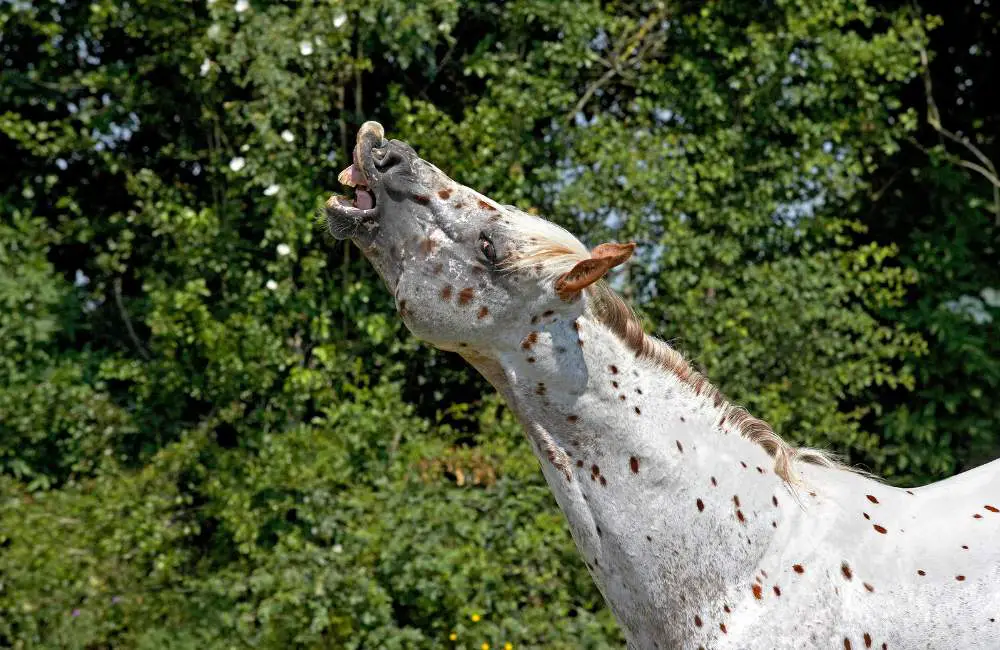
Horse Olfactory Systems
The horse’s olfactory system is the nasal structure that gives them their sense of smell.
That great sense of smell mentioned above is thanks to a large nasal cavity. This part of their respiratory system is made of cartilage and a structure called turbinate bones.
When air is inhaled, it stirs around the turbinate bones, causing the smell to be more evenly distributed.
The horse’s olfactory receptors are found at the top of the nasal cavity. This may sound a bit complex, but bear with me!
Olfactory epithelium (cellular tissue) lines this part of the upper nasal cavity and connects olfactory (remember, that means scent) neurons to accessory olfactory bulbs in the horse’s brain.
Basically, the accessory olfactory organ, works like a reflex. When activated, the smell goes straight to the ancient primal parts of the horse’s brain, such as the amygdala and the hypothalamus, and starts a response right away.
Pretty impressive, right?
Horses can then make decisions about those inhaled scent molecules, like whether to run away quickly because a predator is around or, in most cases, to grab their favorite treat from their human’s hand as soon as possible.
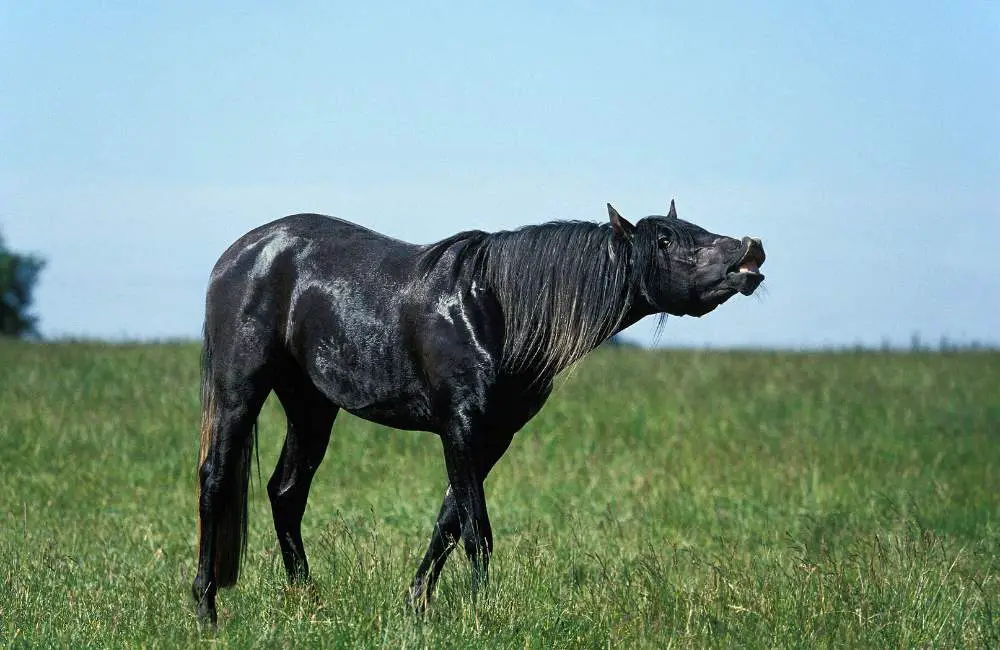
Likely Flehmen Triggers
Stallions are the most common type of horse to show a flehmen response, most often after sniffing a mare in estrus, which means in heat.
In other words, he is checking to see whether she is ready to mate, and these pheromones illicit the flehmen response. When stallions are in the presence of a mare in heat, they might flehmen several times an hour.
Visual cues may be important in the stallion’s response as well. Stallions that couldn’t see mares urinating showed a lower frequency of flehmen than stallions that could.
“It appears that flehmen facilitate the chemosensory priming of stallions for reproductive behavior, rather than being an immediate component of sexual behavior,” said Crowell-Davis.
Another thing that can make stallions exhibit this behavior is the smell of manure.
With mares, smelling the newborn foal after giving birth and the amniotic fluid surrounding it can often cause the reaction. This helps the mother identify her foal and assess its health by taking in its pheromones.
Do Geldings React To Mares In Heat With The Flehmen Response?
Some people think that when a stallion is gelded, he loses the ability to detect and analyze pheromones, making him sexually ineffective in more than one way.
Although geldings are the least likely of the three (mares, stallions, and geldings) to have a flehmen reaction, they still flehmen.
Most horses, including geldings, will have a flehmen reaction to the pheromones present in a mare’s urine when she is in estrus.
Other Triggers
Horses display the flehmen response when investigating new smells or certain scents.
Smells like a new supplement, paint, and smoke can make horses flehmen, among many other things that your horse wants to get a better whiff of.
Another common trigger is when horses are dewormed with an oral dewormer.
Also, like I mentioned earlier, peppermints caused the horse, on which I was taking a lesson, to display this reaction.
So horse treats that seem strange or interesting may cause it.
Horse Behavior Misinterpreted As The Flehmen Response
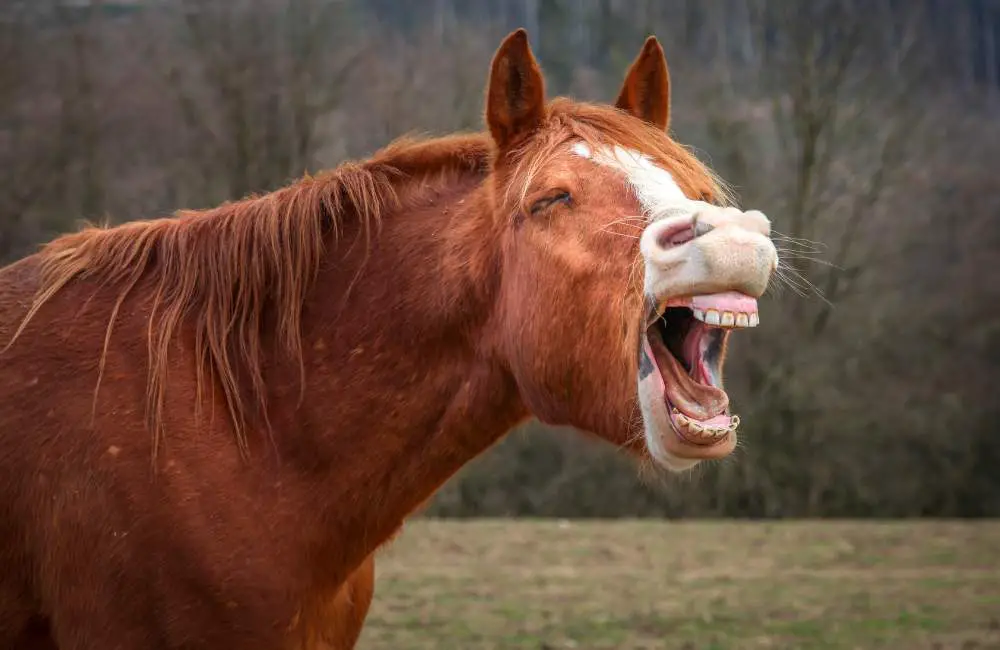
Yawning
A horse’s yawning can be misinterpreted as them having a flehmen reaction.
A good way to tell the difference between the two is to look at the horse’s eyes. They will generally close their eyes when having a good yawn.
Another straightforward example is their mouth opening wide during a yawn. When a horse has a flehmen reaction, their mouth does not open.
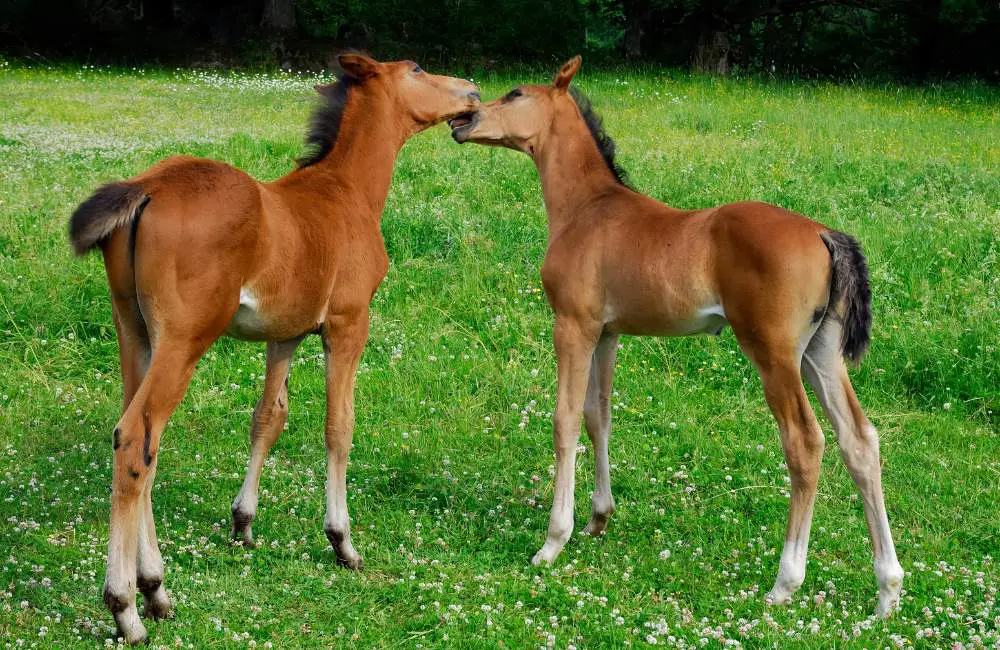
Champing
Champing or snapping can also be misinterpreted as the flehmen response.
This is a typical behavior for young horses (particularly foals that have been weaned from their mothers) when meeting older horses. This is a sign of submission.
They will stretch their head forward and lift their top lip while champing their mouth open and closed. It looks like they are chewing on the air.
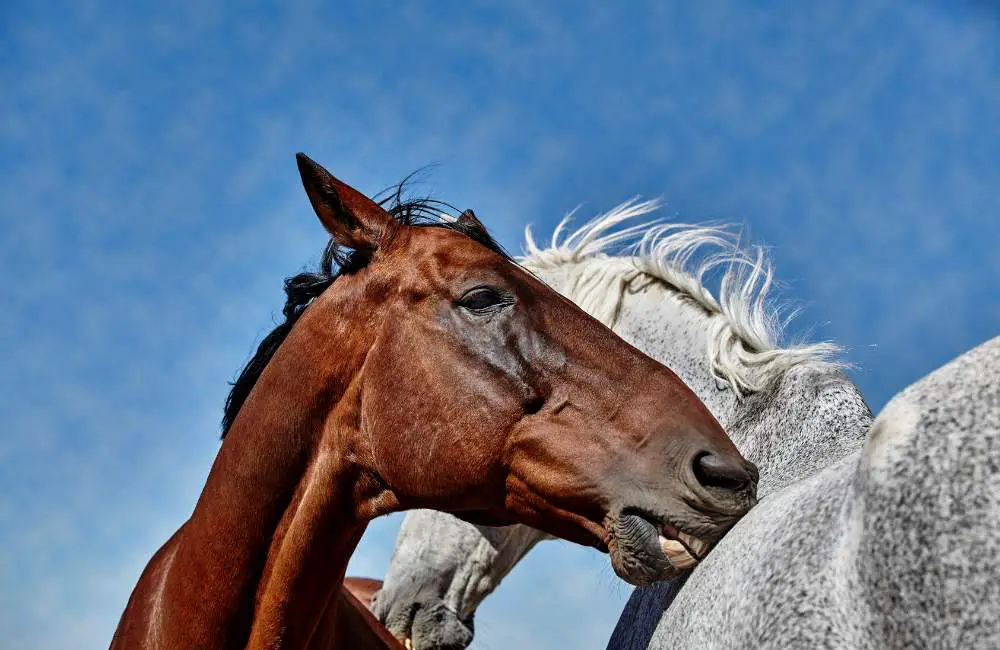
Wiggling Upper Lip
When a horse wiggles their upper lip it could be confused for the flehmen response.
Horses usually do this with their upper lip when they are getting a good scratch.
They will lift their head and wiggle their lip in pleasure.
They may also wiggle their lip to groom a nearby horse or person to show appreciation for being scratched or to initiate mutual grooming.
Can Foals Have A Flehmen Reaction?
Yes, foals can show a flehmen reaction as early as one day old. Actually, the flehmen response is most common in foals during their first month of life. The world is a new and exciting place for them, and so are all the smells.
If you have ever met a newborn foal, it isn’t uncommon for them to curl their little upper lip after smelling you. This smile is especially cute since they don’t yet have teeth at this age.
Both fillies and colts can flehmen, but it has been observed that colts flehmen up to five times more frequently than fillies. As fillies get older, they will have a flehmen reaction less and less often.
Is The Flehmen Response In Horses Ever Pain-Related?
Absolutely. The flehmen response can show signs of pain, particularly early signs of colic discomfort setting in.
Colic is abdominal pain, which for horses usually originates in their gastrointestinal tract.
Three common types of colic in horses are gas, impaction, and functional obstruction.
The most common type of colic is gas colic, and thankfully, many horses recover with minimal medical treatment.F
The other types can be life-threatening. As a horse owner, it is essential to recognize when your horse’s flehmen reaction is not due to a smell but rather a pain.
Check for any other behavior that isn’t normal, like pawing, lying down, or looking at their stomach. If you see any of these, speak to your vet.
Early treatment can give your horse the best chance of recovering.
What Does It Mean When A Horse Shows Its Teeth To You?
Suppose you see a horse showing teeth without the other signs of the flehmen response (i.e., flaring upper lip, raising the head, and inhaling).
In that case, this may be a sign of aggression or agitation.
The best indicator for this would be the horse’s ears. An upset or aggressive horse will have their ears back, and the whites of their eyes will often show.
If you are not experienced with horses, it is safest to back away in these situations.
If a horse is flehmening after sniffing you, there is nothing to worry about. They are just making sure to get an extra good whiff of you!
If a horse shows their teeth to a pasture buddy, that is often their way of saying “back off.” Maybe the other horse is bothering them, or the one is trying to assert dominance.
Either way, this is a natural part of horse behavior. You don’t need to step in unless one horse is hurting the other and you need to separate them.
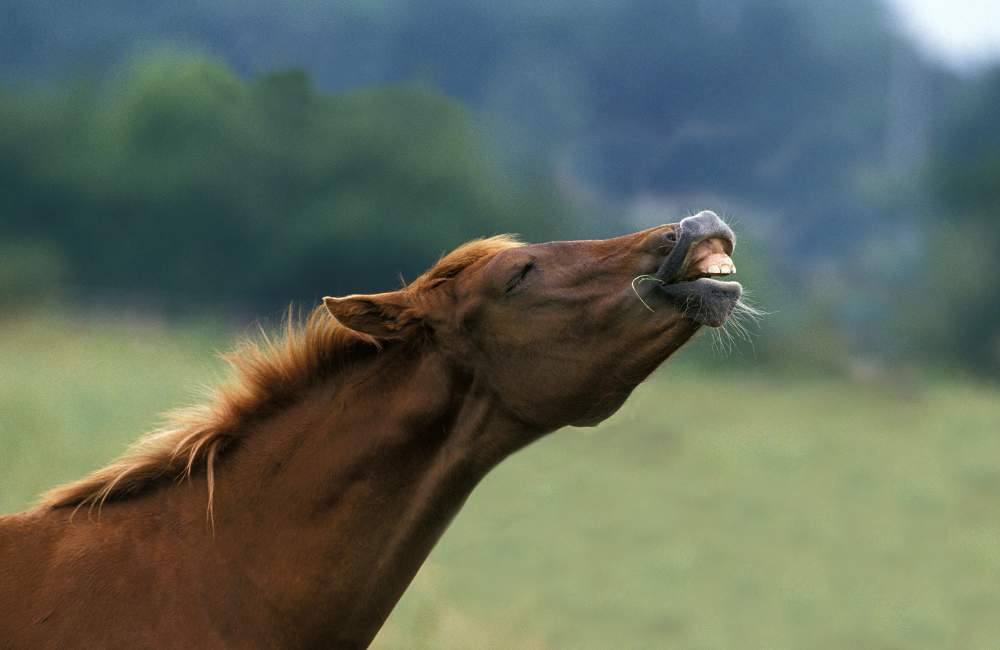
Do Horses Ever Laugh or Smile?
Well, it depends on your definition of a smile. If a horse showing teeth is smiling, then yes! They have the flehmen response.
Suppose you think of smiling as a way of expressing happiness, then no. Horses don’t smile. As for laughing, those funny faces horses make may look like they are cracking up at someone’s joke.
In reality, horses cannot laugh. But when they yawn or have a flehmen response, the horse’s lip flapping can certainly look like it!
Fun Fact: You Can Train Your Horse To Smile
You can teach your horse to do this! Use a word (such as “smile”) or a signal when presenting your horse with a strong or strange smell.
When instinct kicks in and you get that upper lip curl, while they are still performing the flehmening response, reward them!
Do that over and over until the horse has associated raising their lip with getting a treat or praise.
Now you have a horse that can smile for selfies!
Flehmen Response In Horses: Now You Know
Now you know horses are not intentionally smiling. I created this article so you know the truth behind the horse’s smile.
Let me know in the comments:
What did you think the first time you saw a horse do this? Or have you ever seen a horse do this in person?
Cheers, Kacey

